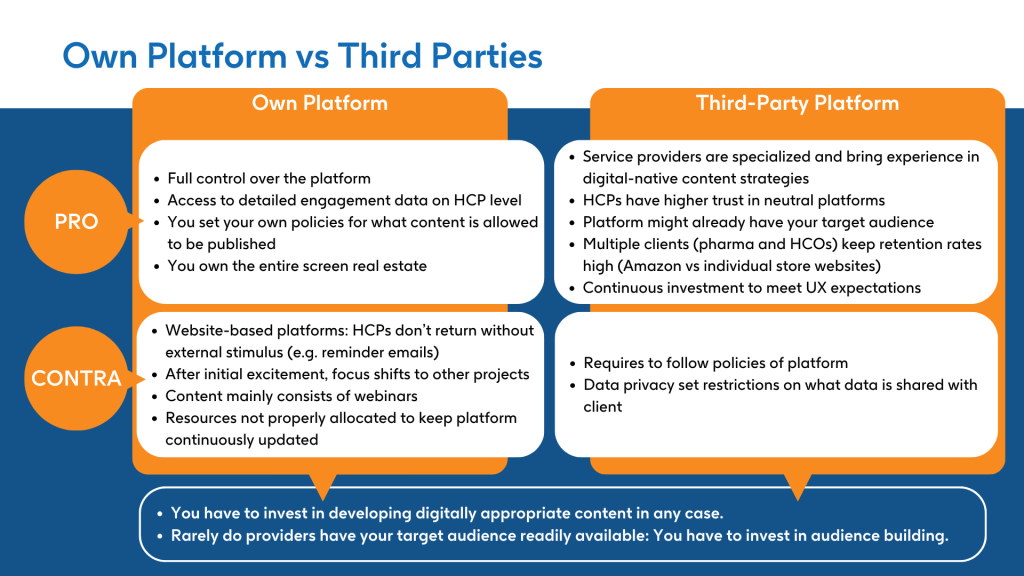Running Your Own Website vs. Using a Third-Party Platform
In the dynamic landscape of healthcare, pharma companies continually seek effective strategies to engage healthcare professionals (HCPs). A pivotal decision in this endeavor is choosing between running a dedicated company website or leveraging a third-party platform. Both approaches offer unique advantages and face specific challenges. Here, we delve into the nuanced pros and cons of each option, weaving a story that illustrates the strategic considerations for pharma companies.
The Autonomy of Running Your Own Website
Imagine you are a pharmaceutical company embarking on a journey to create a robust online presence. Owning your platform feels empowering. You have complete control over every aspect—from the design and user experience to the content policies and engagement strategies. This autonomy allows for a tailored approach that perfectly aligns with your brand’s identity and goals. You can meticulously track engagement data at the HCP level, gaining insights that inform your strategies and drive targeted actions.
However, the journey is not without its hurdles. While the initial excitement fuels rapid development, sustaining momentum can be challenging. HCPs, with their demanding schedules, may not return to your site without consistent external stimuli, such as reminder emails. Over time, the platform risks becoming static if continuous investment in content and user experience is not maintained. The challenge of keeping the platform vibrant and engaging becomes evident, requiring a dedicated allocation of resources to prevent it from becoming just another static page in the digital sea.
The Strategic Advantage of Third-Party Platforms
On the other hand, consider the strategic advantage of utilizing a third-party platform. These platforms are designed with the expertise of digital-native content strategies, offering a rich array of engaging formats. An EPG Health Report shows that HCPs often trust neutral platforms more than company-owned websites, perceiving them as unbiased sources of information. This trust is invaluable, as it fosters higher engagement and receptiveness to educational content.

Moreover, third-party platforms often come with a pre-built audience, saving you the effort and time of audience building from scratch. This is akin to setting up a shop in a bustling marketplace rather than an isolated street. The presence of multiple clients—both pharma companies and healthcare organizations—ensures higher retention rates, similar to the way consumers frequently visit Amazon over individual store websites. However, this advantage comes with its own set of challenges. You must adhere to the platform’s policies, which might limit your flexibility in presenting content. Additionally, data privacy restrictions may limit the detailed engagement data shared with you, posing a challenge for in-depth analysis and strategy refinement.
Balancing the Pros and Cons
The decision between owning a platform and leveraging a third-party one is not black and white and it is not mutually exclusive. Each path offers distinct benefits that cater to different strategic needs. For a pharma company with substantial resources and a dedicated team, running an own platform might provide the control and customization needed to align perfectly with long-term goals. Conversely, for those looking to rapidly scale and leverage established trust and engagement mechanisms, a third-party platform might be the more pragmatic choice.

Conclusion
In conclusion, the decision between running your own website and using a third-party platform hinges on your company’s specific needs, goals, and resources. Both options offer unique advantages and present particular challenges. By carefully weighing these factors and considering the strategic fit for your organization, you can make an informed decision that optimizes HCP engagement and drives better healthcare outcomes.






